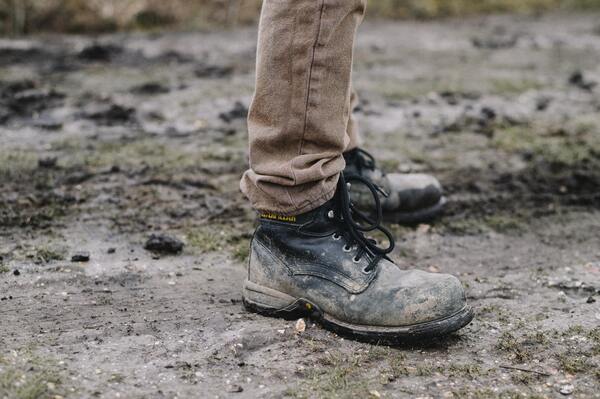Various types of boots can have a steel toe in the front. It could be hiking boots or work boots that have a steel toe. If you are looking for boots with a steel toe, I do not doubt you will be able to find a pair that will fit your needs best.
Still, it would be best if you remembered that not all steel-toed boots are suitable for every situation. Take work boots – they are great in work environments but not for hiking since they lack some crucial capabilities needed for hiking trips.
In today’s guide, I will look into the various types of steel-toed boots to learn if steel-toed boots are suitable for hiking. If you want to learn more about this type of boots and their properties, I recommend that you stick around for the guide!
More...
Table of Contents
What Are Steel Toe Boots Good For?
Many people wear steel-toe boots when working. These shoes come with many certifications that make them perfect for construction sites and other types of work environments. They are durable and rugged, offer excellent protection, and have a sturdy build that can withstand even the harshest working conditions.
Still, it would be best to remember that not all steel-toed boots are identical. Some have waterproof uppers while others do not; some come with better traction than others, while some are more comfortable than others. It depends on the particular boot and the manufacturer.
Many great companies make such steel-toed boots, so you should be able to find a pair that will fit your needs best easily. Make sure to look into all the properties and capabilities of the boots and then decide which ones you like best, depending on what you need the boots for.
If you want to use steel-toe boots for hiking, that is a different conversation that should focus on other boot properties. I will get more into that in the following section.

Steel-Toed Boots vs. Regular Hiking Boots – What’s the Difference?
Even though it may not look like it, there are many differences between steel-toed work boots and regular hiking boots. These shoes have more differences than similarities, and those differences can deem them unusable for specific situations.
Before hiking with your work boots, you need to know a few crucial differences that can make or break your trip. Let’s look into them more closely:
Weight
As you might suspect, the steel part in steel-toe work boots makes these boots quite heavy. You can find such a piece in some steel-toe hiking boots, but that is less likely. Steel toes are more common in work boots and then make the boots way too heavy for hiking.
If you take steel-toed boots hiking, you must remember that your feet will feel heavy and tired. This means that these boots are not that suitable for longer hikes.
Regarding weight, hiking boots with or without steel toes are more suitable. This is because the whole construction of the boots is based on lightness, lightweight material, rubber soles that do not weigh the foot down, and so on. In such shoes, the steel toe will not be as noticeable as on a work boot.
Waterproofing
People who wear work boots often work in factories or construction sites, where they have at least some kind of protection from harsher weather conditions. Their shoes might or might not need waterproofing and water-repellency.
While waterproofing might not be that important on work boots, it is vital on hiking boots. When hiking, you often have to deal with streams, puddles you cannot walk around, unexpected rain or snow, and so on. This means you need boots that can protect you at all times, even when the weather is worse.
So, the difference between hiking and work boots with steel toes is that the former are usually waterproof while the latter are rarely waterproof. That deems the latter unusable on certain hikes while also quite challenging to dry and keep. Remember that when determining if you want to hike with your work boots.
Traction
Traction is also an essential feature of hiking boots. Whether they have steel toes or not, hiking boots always have excellent traction. That makes them suitable for various terrain and weather, helping you get through any obstacle without worrying.
The same cannot be said for work shoes with steel toes because they do not offer good traction. The sole can be thick but without groves, which means it can slip when walking on damp ground, puddles, or any terrain that is not flat.
Boots of any kind that do not come with good traction are not suitable for hiking. It would be best to go for steel-toe hiking boots with a great sole, deep groves, and slip resistance. The sole will keep the feet from slipping, while the steel toe will protect your toes in case you bump into something while hiking.
Breathability
Regarding breathability, hiking shoes win over steel-toed work boots for hiking. That is because most hiking boots are made from breathable material that does not allow your feet to sweat and slip around in the shoe. I cannot say the same for work boots because they usually do not offer good breathability.
If the shoes do not have good breathability, your feet will become sweaty and feel uncomfortable after some time. If you want to go on a longer hike, it will certainly not be pleasant because of all the discomfort.
So, before heading on a hike, always ensure your shoes are breathable. If you do not have the option to wear breathable boots, consider taking a few pairs of socks that you can change between whenever your feet become sweaty.
Flexibility
Hiking boots are flexible and offer great comfort and traction on all terrain. These boots often have groove soles paired with an Eva foam insole, making the boots suitable even for rough terrain and rocks.
As for work boots, most of them are not even the least flexible. They have a rigid build that is sometimes too rigid for hiking trails. They are made for specific environments where people do not need to walk on uneven terrain or rocks.
If you plan to go on a more demanding hike, you should give your boot choice a second thought. You do not want to go on a trip only to find that your boots make it impossible for you to move. If you suspect the work boots will not be flexible enough and you do not have the option of wearing hiking boots, consider wearing a pair of running shoes instead.

Can I Wear Work Boots for Hiking?
So, are steel-toed boots suitable for hiking, you ask? The answer has to be both yes and no. It depends on the type of boots you have and the type of hike you are planning.
Steel-toe hiking boots are the best option for hiking, but they can be expensive. If you are new to hiking or cannot afford to get a separate pair of hiking boots, you can use your work boots. In that case, you will have to limit yourself to short, less demanding hikes that you go to only when the weather is nice.
The work boots you wear on a hike need good foot and ankle support, at least some waterproofing, a durable build, and a sturdy sole suitable for various terrain. The most important thing is for them to feel comfortable – to be worn in and the right size for your feet.
To ensure your work boots offer these properties, take them on a short walk before the hike. That way, you will know if you feel comfortable enough to wear them when hiking or if you want to hike in some other shoes.
Can Hiking Boots Be Used as Work Boots?
In some instances, you can wear a steel-toe hiking boot to work. For that to happen, you must exhaust all other options. If you have a regular work boot, I recommend wearing that one to work. If not, traditional hiking boots can be your backup option.
Still, hiking boots are less sturdy than actual work boots. They might even lack the steel toe cap, making them unusable for some work environments. On the plus side, they will offer excellent breathability, comfort, waterproofing, flexibility, traction, and other things. Not having that extra weight on your feet might make you feel better than ever, even if you have worked with heavy boots your entire career.
Wrap-Up
While you can use hiking boots in work environments and work boots for hiking, it is best to stick to the boot’s intended use. Work boots are suitable for hiking, but only if you plan a less demanding and short hike in good weather. In any other case, they might cause more problems than they solve.
- Are Merrell Shoes Good? – An Unbiased Review of Merrell Footwear - December 9, 2023
- Where Are Merrell Shoes Made? - December 9, 2023
- Camping in 40-degree Weather: Tips and Tricks - September 25, 2023



![Are Hiking Boots Good For Snow? [Everything You Need To Know] Are Hiking Boots Good For Snow? [Everything You Need To Know]](https://grandcircletrails.com/wp-content/uploads/2021/11/Are-Hiking-Boots-Good-For-Snow-1-150x150.jpg)

![Are Keen Sandals Good for Hiking? [Are They Really Good For Hike?] Are Keen Sandals Good for Hiking? [Are They Really Good For Hike?]](https://grandcircletrails.com/wp-content/uploads/2022/06/are-keen-sandals-good-for-hiki-1-150x150.png)
